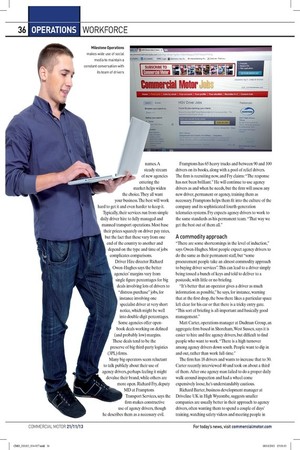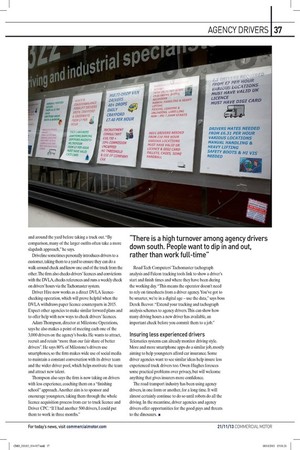Getting the best out of agency drivers
Page 25

Page 26

Page 27

If you've noticed an error in this article please click here to report it so we can fix it.
Some firms see them as an asset, others as a necessary evil. Whatever your point of view, you need to get used to agency drivers By Robin Dickeson
ACCORDING TO Bradford-based Driver Hire: "Every truck or courier van in the UK is operated by a current or potential customer." The business goes on to claim that the UK market for temporary drivers is worth a staggeringi2bn a year.
Operators use agency drivers to help even out peaks in-demand, 'usually through the summer holidays and over the Christmas period. Despite the growing number of agency drivers on our roads, agencies say they still find operators that prefer to stand a truck against the wall for a day rather than hire an agency driver. Other firms will hire an agency driver to avoid letting down a customer, although the costs might be more than the job is worth.
A good agency, when used as a business partner rather than a commodity supplier, can be a valuable long-term asset, taking much of the hassle out of sourcing scarce drivers. And as bureaucracy builds, that hassle will grow.
Finding a good driver agency involves the same commercial common sense you use to find virtually any other supplier. Talk to other operators, particularly those you know and trust in the same field as you; ask for recommendations; get references. Play one agency against another and shop around. Agencies vary from small regional-based firms through to big national operations with strings of blue-chip customers to their names. A steady stream of new agencies entering the market helps widen the choice. They all want your business. The best will work
hard to get it and even harder to keep it. Typically, their services run from simple daily driver hire to fully managed and manned transport operations. Most base their prices squarely on driver pay rates, but the fact that these vary from one end of the country to another and
depend on the type and time of jobs complicates comparisons. Driver Hire director Richard Owen-Hughes says the better agencies' margins vary from single figure percentages for big deals involving lots of drivers to "distress purchase" jobs, for
instance involving one specialist driver at very short notice, which might be well into double-digit percentages. Some agencies offer open book deals working on defined (and probably low) margins
These deals tend to be the preserve of big third-party logistics (3PL) firms. Many big operators seem reluctant to talk publicly about their use of agency drivers, perhaps feeling it might devalue their brand, while others are more open. Richard Fry, deputy MD at Framptons Transport Services, says the firm makes constructive
use of agency drivers, though he describes them as a necessary evil.
Framptons has 65 heavy trucks and between 90 and 100 drivers on its books, along with a pool of relief drivers. The firm is recruiting now, and Fry claims: "The response has not been brilliant." He will continue to use agency drivers as and when he needs, but the firm will assess any new driver, permanent or agency, training them as necessary. Framptons helps them fit into the culture of the company and its sophisticated fourth-generation telematics systems. Fry expects agency drivers to work to the same standards as his permanent team. "That way we get the best out of them all." A commodity approach
"There are some shortcomings in the level of induction," says Owen-Hughes. Most people expect agency drivers to do the same as their permanent staff but "some procurement people take an almost commodity approach to buying driver services". This can lead to a driver simply being tossed a bunch of keys and told to deliver to a postcode, with little or no briefing.
"It's better that an operator gives a driver as much information as possible," he says, for instance, warning that at the first drop, the boss there likes a particular space left clear for his car or that there is a tricky entry gate. "This sort of briefing is all-important and basically good management."
Matt Carter, operations manager at Dudman Group, an aggregate firm based in Shoreham, West Sussex, says it is easier to hire and fire agency drivers, but difficult to find people who want to work. "There is a high turnover among agency drivers down south. People want to dip in and out, rather than work full-time."
The firm has 18 drivers and wants to increase that to 30. Carter recently interviewed 40 and took on about a third of them. After one agency man failed to do a proper daily walk-around inspection and had a wheel come expensively loose, he's understandably cautious. Richard Barter, business development manager at Driveline UK in High Wycombe, suggests smaller companies are usually better in their approach to agency drivers, often wanting them to spend a couple of days' training, watching safety videos and meeting people in
and around the yard before taking a truck out. "By comparison, many of the larger outfits often take a more slapdash approach," he says.
Driveline sometimes personally introduces drivers to a customer, taking them to a yard to ensure they can do a walk-around check and know one end of the truck from the other. The firm also checks drivers' licences and convictions with the DVLA, checks references and runs a weekly check on drivers' hours via the Tachomaster system.
Driver Hire now works as a direct DVLA licencechecking operation, which will prove helpful when the DVLA withdraws paper licence counterparts in 2015. Expect other agencies to make similar forward plans and to offer help with new ways to check drivers' licences.
Adam Thompson, director at Milestone Operations, says he also makes a point of meeting each one of the 3,000 drivers on the agency's books. He wants to attract, recruit and retain "more than our fair share of better drivers". He says 80% of Milestone's drivers use smartphones, so the firm makes wide use of social media to maintain a constant conversation with its driver team and the wider driver pool, which helps motivate the team and attract new talent.
Thompson also says the firm is now taking on drivers with less experience, coaching them on a "finishing school" approach. Another aim is to sponsor and encourage youngsters, taking them through the whole licence acquisition process from car to truck licence and Driver CPC. "If I had another 500 drivers, I could put them to work in three months."
Road Tech Computers' Tachomaster tachograph analysis and Falcon tracking tools link to show a driver's start and finish times and where they have been during the working day. "This means the operator doesn't need to rely on timesheets from a driver agency. You've got to be smarter, we're in a digital age — use the data," says boss Derek Beevor. "Extend your tracking and tachograph analysis schemes to agency drivers. This can show how many driving hours a new driver has available, an important check before you commit them to a job." Insuring less experienced drivers
Telematics systems can already monitor driving style. More and more smartphone apps do a similar job, mostly aiming to help youngsters afford car insurance. Some driver agencies want to see similar ideas help insure less experienced truck drivers too. Owen-Hughes foresees some practical problems over privacy, but will welcome anything that gives insurers more confidence. The road transport industry has been using agency drivers, in one form or another, for a long time. It will almost certainly continue to do so until robots do all the driving. In the meantime, driver agencies and agency drivers offer opportunities for the good guys and threats to the dinosaurs. •






































